Strategic Management Approaches: A Comparison of Three Key Approaches
VerifiedAdded on 2022/10/19
|16
|2990
|17
Report
AI Summary
This report provides a comprehensive overview of three strategic management approaches: sustainable, stakeholder, and dynamic capabilities. It begins with an introduction to strategic management, emphasizing the importance of aligning organizational goals with available resources and environmental factors. The report delves into each approach, discussing their respective benefits, implementation issues, and limitations. The sustainable approach focuses on operational relevance and meeting customer needs, the stakeholder approach emphasizes satisfying stakeholder needs for long-term success, and the dynamic capabilities approach centers on leveraging employee skills and expertise. Real-world examples of organizations successfully implementing these approaches, such as Starbucks and Facebook, are provided to illustrate their practical application. The report concludes with an evaluation of each approach's success, offering valuable insights into strategic decision-making for managers and academics.

Running head: MANAGEMENT
Strategic Management
Name of the Student:
Name of the University:
Author Note:
Strategic Management
Name of the Student:
Name of the University:
Author Note:
Paraphrase This Document
Need a fresh take? Get an instant paraphrase of this document with our AI Paraphraser

1MANAGEMENT
Executive Summary:
The aim of the report is to provide an overview of three approaches of strategic management.
The approaches discussed here is the sustainable approach, stakeholder approach and the
dynamic capabilities. The report compares and contrasts between the three approaches based on
benefits, implementation issues and limitation. The report also puts forward an example of each
of the approach and puts forward the evaluation of each of the approach.
Executive Summary:
The aim of the report is to provide an overview of three approaches of strategic management.
The approaches discussed here is the sustainable approach, stakeholder approach and the
dynamic capabilities. The report compares and contrasts between the three approaches based on
benefits, implementation issues and limitation. The report also puts forward an example of each
of the approach and puts forward the evaluation of each of the approach.

2MANAGEMENT
Table of Contents
Introduction:....................................................................................................................................2
Sustainable Approach:.....................................................................................................................3
Benefits:.......................................................................................................................................4
Limitations:..................................................................................................................................5
Example of the Organization:......................................................................................................5
Success of the Approach:.............................................................................................................5
Stakeholder Approach:....................................................................................................................6
Benefits:.......................................................................................................................................6
Implementation Issues:................................................................................................................7
Limitations:..................................................................................................................................7
Example of the Organization:......................................................................................................8
Success of the Approach:.............................................................................................................8
Dynamic Capabilities.......................................................................................................................8
Benefits:.......................................................................................................................................9
Implementation Issues:................................................................................................................9
Limitations:..................................................................................................................................9
Example of Organization:............................................................................................................9
Evaluation of the Success of Approach:....................................................................................10
Conclusion:....................................................................................................................................10
References:....................................................................................................................................11
Table of Contents
Introduction:....................................................................................................................................2
Sustainable Approach:.....................................................................................................................3
Benefits:.......................................................................................................................................4
Limitations:..................................................................................................................................5
Example of the Organization:......................................................................................................5
Success of the Approach:.............................................................................................................5
Stakeholder Approach:....................................................................................................................6
Benefits:.......................................................................................................................................6
Implementation Issues:................................................................................................................7
Limitations:..................................................................................................................................7
Example of the Organization:......................................................................................................8
Success of the Approach:.............................................................................................................8
Dynamic Capabilities.......................................................................................................................8
Benefits:.......................................................................................................................................9
Implementation Issues:................................................................................................................9
Limitations:..................................................................................................................................9
Example of Organization:............................................................................................................9
Evaluation of the Success of Approach:....................................................................................10
Conclusion:....................................................................................................................................10
References:....................................................................................................................................11
⊘ This is a preview!⊘
Do you want full access?
Subscribe today to unlock all pages.

Trusted by 1+ million students worldwide
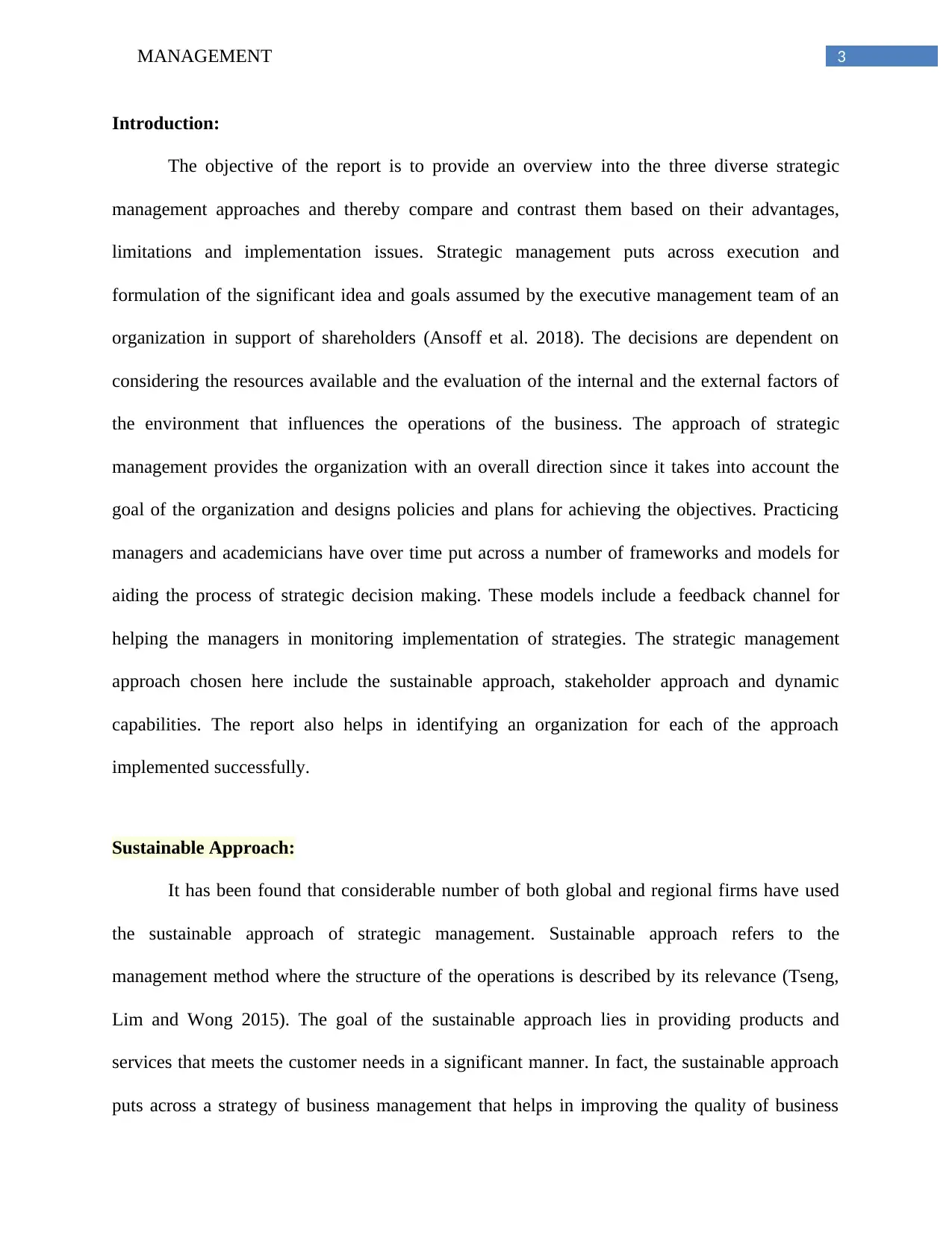
3MANAGEMENT
Introduction:
The objective of the report is to provide an overview into the three diverse strategic
management approaches and thereby compare and contrast them based on their advantages,
limitations and implementation issues. Strategic management puts across execution and
formulation of the significant idea and goals assumed by the executive management team of an
organization in support of shareholders (Ansoff et al. 2018). The decisions are dependent on
considering the resources available and the evaluation of the internal and the external factors of
the environment that influences the operations of the business. The approach of strategic
management provides the organization with an overall direction since it takes into account the
goal of the organization and designs policies and plans for achieving the objectives. Practicing
managers and academicians have over time put across a number of frameworks and models for
aiding the process of strategic decision making. These models include a feedback channel for
helping the managers in monitoring implementation of strategies. The strategic management
approach chosen here include the sustainable approach, stakeholder approach and dynamic
capabilities. The report also helps in identifying an organization for each of the approach
implemented successfully.
Sustainable Approach:
It has been found that considerable number of both global and regional firms have used
the sustainable approach of strategic management. Sustainable approach refers to the
management method where the structure of the operations is described by its relevance (Tseng,
Lim and Wong 2015). The goal of the sustainable approach lies in providing products and
services that meets the customer needs in a significant manner. In fact, the sustainable approach
puts across a strategy of business management that helps in improving the quality of business
Introduction:
The objective of the report is to provide an overview into the three diverse strategic
management approaches and thereby compare and contrast them based on their advantages,
limitations and implementation issues. Strategic management puts across execution and
formulation of the significant idea and goals assumed by the executive management team of an
organization in support of shareholders (Ansoff et al. 2018). The decisions are dependent on
considering the resources available and the evaluation of the internal and the external factors of
the environment that influences the operations of the business. The approach of strategic
management provides the organization with an overall direction since it takes into account the
goal of the organization and designs policies and plans for achieving the objectives. Practicing
managers and academicians have over time put across a number of frameworks and models for
aiding the process of strategic decision making. These models include a feedback channel for
helping the managers in monitoring implementation of strategies. The strategic management
approach chosen here include the sustainable approach, stakeholder approach and dynamic
capabilities. The report also helps in identifying an organization for each of the approach
implemented successfully.
Sustainable Approach:
It has been found that considerable number of both global and regional firms have used
the sustainable approach of strategic management. Sustainable approach refers to the
management method where the structure of the operations is described by its relevance (Tseng,
Lim and Wong 2015). The goal of the sustainable approach lies in providing products and
services that meets the customer needs in a significant manner. In fact, the sustainable approach
puts across a strategy of business management that helps in improving the quality of business
Paraphrase This Document
Need a fresh take? Get an instant paraphrase of this document with our AI Paraphraser
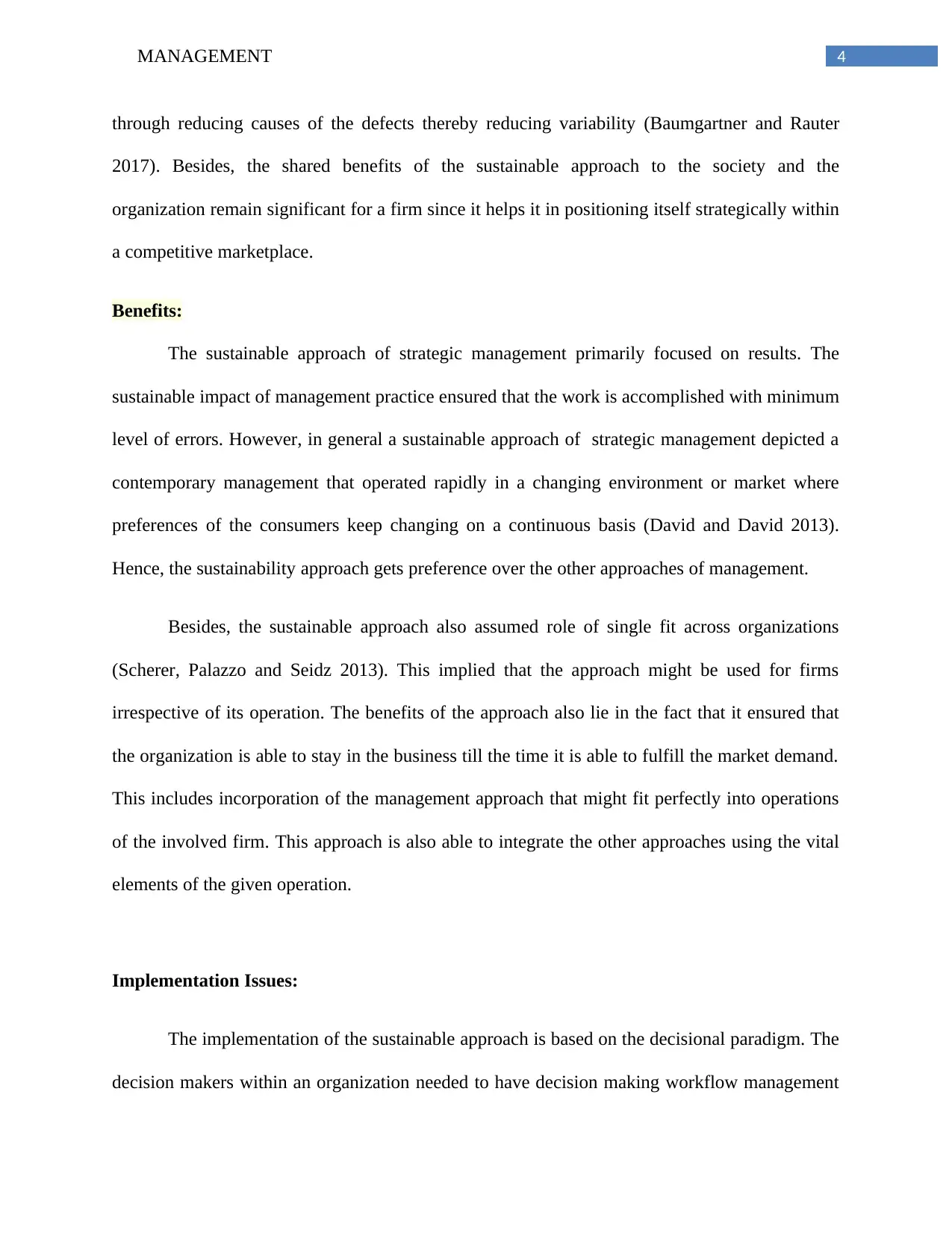
4MANAGEMENT
through reducing causes of the defects thereby reducing variability (Baumgartner and Rauter
2017). Besides, the shared benefits of the sustainable approach to the society and the
organization remain significant for a firm since it helps it in positioning itself strategically within
a competitive marketplace.
Benefits:
The sustainable approach of strategic management primarily focused on results. The
sustainable impact of management practice ensured that the work is accomplished with minimum
level of errors. However, in general a sustainable approach of strategic management depicted a
contemporary management that operated rapidly in a changing environment or market where
preferences of the consumers keep changing on a continuous basis (David and David 2013).
Hence, the sustainability approach gets preference over the other approaches of management.
Besides, the sustainable approach also assumed role of single fit across organizations
(Scherer, Palazzo and Seidz 2013). This implied that the approach might be used for firms
irrespective of its operation. The benefits of the approach also lie in the fact that it ensured that
the organization is able to stay in the business till the time it is able to fulfill the market demand.
This includes incorporation of the management approach that might fit perfectly into operations
of the involved firm. This approach is also able to integrate the other approaches using the vital
elements of the given operation.
Implementation Issues:
The implementation of the sustainable approach is based on the decisional paradigm. The
decision makers within an organization needed to have decision making workflow management
through reducing causes of the defects thereby reducing variability (Baumgartner and Rauter
2017). Besides, the shared benefits of the sustainable approach to the society and the
organization remain significant for a firm since it helps it in positioning itself strategically within
a competitive marketplace.
Benefits:
The sustainable approach of strategic management primarily focused on results. The
sustainable impact of management practice ensured that the work is accomplished with minimum
level of errors. However, in general a sustainable approach of strategic management depicted a
contemporary management that operated rapidly in a changing environment or market where
preferences of the consumers keep changing on a continuous basis (David and David 2013).
Hence, the sustainability approach gets preference over the other approaches of management.
Besides, the sustainable approach also assumed role of single fit across organizations
(Scherer, Palazzo and Seidz 2013). This implied that the approach might be used for firms
irrespective of its operation. The benefits of the approach also lie in the fact that it ensured that
the organization is able to stay in the business till the time it is able to fulfill the market demand.
This includes incorporation of the management approach that might fit perfectly into operations
of the involved firm. This approach is also able to integrate the other approaches using the vital
elements of the given operation.
Implementation Issues:
The implementation of the sustainable approach is based on the decisional paradigm. The
decision makers within an organization needed to have decision making workflow management
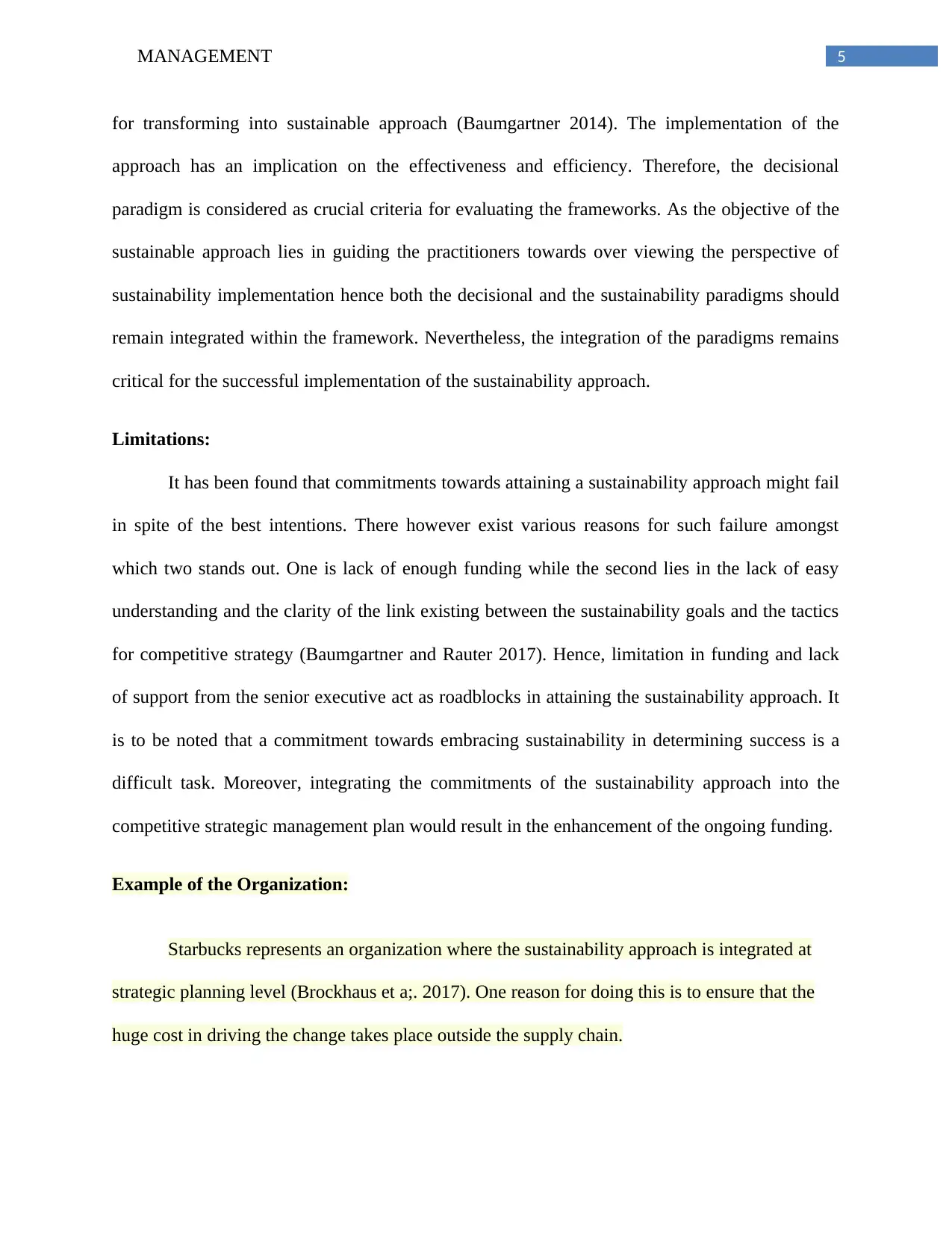
5MANAGEMENT
for transforming into sustainable approach (Baumgartner 2014). The implementation of the
approach has an implication on the effectiveness and efficiency. Therefore, the decisional
paradigm is considered as crucial criteria for evaluating the frameworks. As the objective of the
sustainable approach lies in guiding the practitioners towards over viewing the perspective of
sustainability implementation hence both the decisional and the sustainability paradigms should
remain integrated within the framework. Nevertheless, the integration of the paradigms remains
critical for the successful implementation of the sustainability approach.
Limitations:
It has been found that commitments towards attaining a sustainability approach might fail
in spite of the best intentions. There however exist various reasons for such failure amongst
which two stands out. One is lack of enough funding while the second lies in the lack of easy
understanding and the clarity of the link existing between the sustainability goals and the tactics
for competitive strategy (Baumgartner and Rauter 2017). Hence, limitation in funding and lack
of support from the senior executive act as roadblocks in attaining the sustainability approach. It
is to be noted that a commitment towards embracing sustainability in determining success is a
difficult task. Moreover, integrating the commitments of the sustainability approach into the
competitive strategic management plan would result in the enhancement of the ongoing funding.
Example of the Organization:
Starbucks represents an organization where the sustainability approach is integrated at
strategic planning level (Brockhaus et a;. 2017). One reason for doing this is to ensure that the
huge cost in driving the change takes place outside the supply chain.
for transforming into sustainable approach (Baumgartner 2014). The implementation of the
approach has an implication on the effectiveness and efficiency. Therefore, the decisional
paradigm is considered as crucial criteria for evaluating the frameworks. As the objective of the
sustainable approach lies in guiding the practitioners towards over viewing the perspective of
sustainability implementation hence both the decisional and the sustainability paradigms should
remain integrated within the framework. Nevertheless, the integration of the paradigms remains
critical for the successful implementation of the sustainability approach.
Limitations:
It has been found that commitments towards attaining a sustainability approach might fail
in spite of the best intentions. There however exist various reasons for such failure amongst
which two stands out. One is lack of enough funding while the second lies in the lack of easy
understanding and the clarity of the link existing between the sustainability goals and the tactics
for competitive strategy (Baumgartner and Rauter 2017). Hence, limitation in funding and lack
of support from the senior executive act as roadblocks in attaining the sustainability approach. It
is to be noted that a commitment towards embracing sustainability in determining success is a
difficult task. Moreover, integrating the commitments of the sustainability approach into the
competitive strategic management plan would result in the enhancement of the ongoing funding.
Example of the Organization:
Starbucks represents an organization where the sustainability approach is integrated at
strategic planning level (Brockhaus et a;. 2017). One reason for doing this is to ensure that the
huge cost in driving the change takes place outside the supply chain.
⊘ This is a preview!⊘
Do you want full access?
Subscribe today to unlock all pages.

Trusted by 1+ million students worldwide
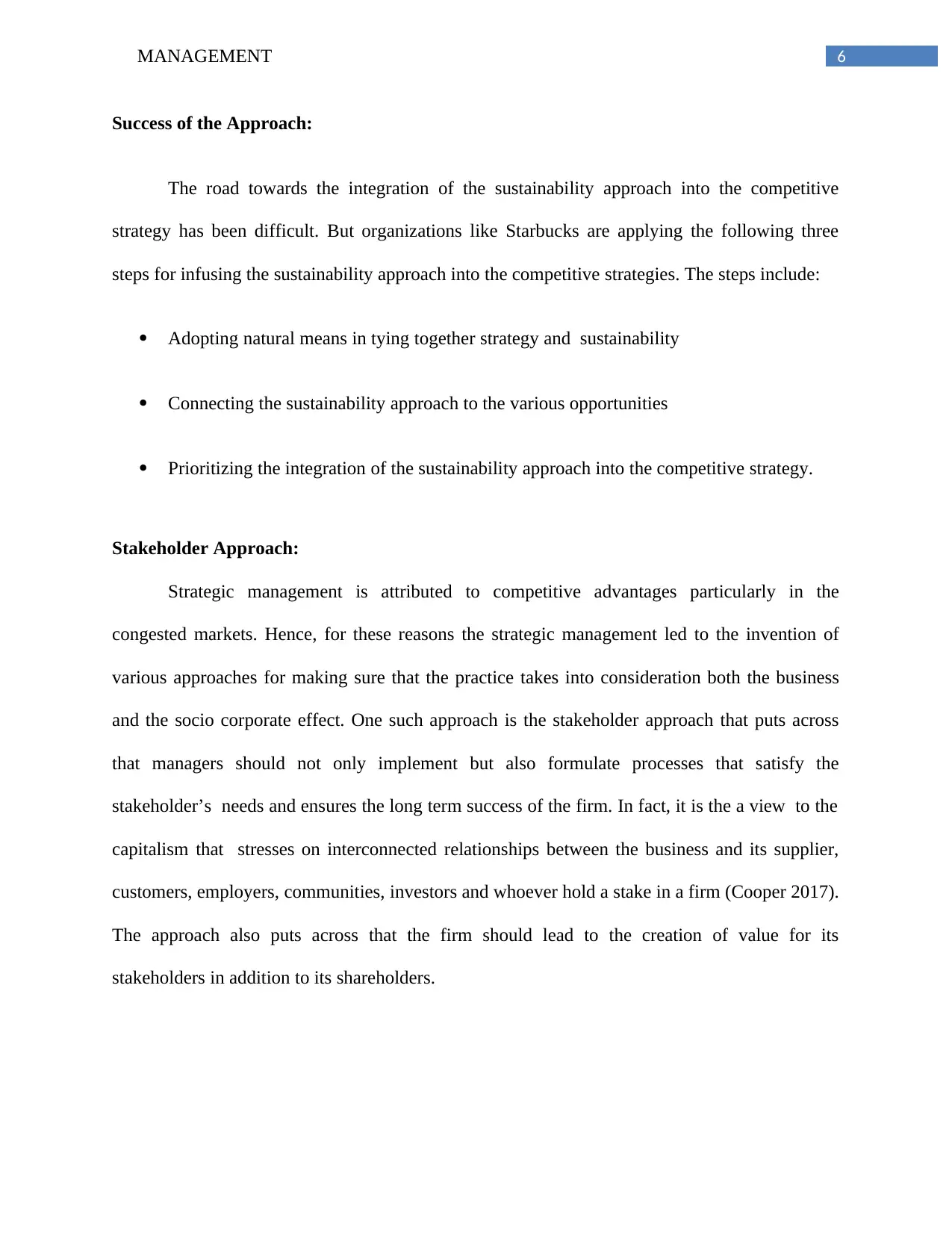
6MANAGEMENT
Success of the Approach:
The road towards the integration of the sustainability approach into the competitive
strategy has been difficult. But organizations like Starbucks are applying the following three
steps for infusing the sustainability approach into the competitive strategies. The steps include:
Adopting natural means in tying together strategy and sustainability
Connecting the sustainability approach to the various opportunities
Prioritizing the integration of the sustainability approach into the competitive strategy.
Stakeholder Approach:
Strategic management is attributed to competitive advantages particularly in the
congested markets. Hence, for these reasons the strategic management led to the invention of
various approaches for making sure that the practice takes into consideration both the business
and the socio corporate effect. One such approach is the stakeholder approach that puts across
that managers should not only implement but also formulate processes that satisfy the
stakeholder’s needs and ensures the long term success of the firm. In fact, it is the a view to the
capitalism that stresses on interconnected relationships between the business and its supplier,
customers, employers, communities, investors and whoever hold a stake in a firm (Cooper 2017).
The approach also puts across that the firm should lead to the creation of value for its
stakeholders in addition to its shareholders.
Success of the Approach:
The road towards the integration of the sustainability approach into the competitive
strategy has been difficult. But organizations like Starbucks are applying the following three
steps for infusing the sustainability approach into the competitive strategies. The steps include:
Adopting natural means in tying together strategy and sustainability
Connecting the sustainability approach to the various opportunities
Prioritizing the integration of the sustainability approach into the competitive strategy.
Stakeholder Approach:
Strategic management is attributed to competitive advantages particularly in the
congested markets. Hence, for these reasons the strategic management led to the invention of
various approaches for making sure that the practice takes into consideration both the business
and the socio corporate effect. One such approach is the stakeholder approach that puts across
that managers should not only implement but also formulate processes that satisfy the
stakeholder’s needs and ensures the long term success of the firm. In fact, it is the a view to the
capitalism that stresses on interconnected relationships between the business and its supplier,
customers, employers, communities, investors and whoever hold a stake in a firm (Cooper 2017).
The approach also puts across that the firm should lead to the creation of value for its
stakeholders in addition to its shareholders.
Paraphrase This Document
Need a fresh take? Get an instant paraphrase of this document with our AI Paraphraser

7MANAGEMENT
Benefits:
The stakeholders approach comes with various incentives for a firm provided the levels
of motivation and the conditions of working remaining conducive. This implies that the profits
undertake an upward curve in the performance graph as portrayed in the financial statements.
However, the objectives of strategic management following the stakeholder approach tend to be
comprehensive as well as all inclusive. In most of the instances, the stakeholder approach
ensures that there exists minimum confrontation from the shareholders since all their basic needs
remains highly prioritized (Ayuso et al., 2014). For instance, it is however noted that the
approach allows equitable sharing amongst the investment partners which leaves little room for
the complaints or the unattended shares. The stakeholder approach also makes sure that the
employees’ fulfills the objective of the firm by ensuring that the wages are met time along with
fair distribution of incentive. Such an approach would do away with the internal and the external
resistance thereby inhibiting the generation of revenue.
Implementation Issues:
It has been that the policies of the stakeholder approach are enacted jointly by the
involved parties. A necessary implementation of change is undertaken after conducting a joint
meeting with the stakeholders for ensuring that the process is not only transparent and
comprehensive (Yawar and Seuring 2017). In this kind of management environments, all the
requirements that are agreed upon during meeting must be amicably met within the shortest
possible time. Most of the barriers of implementing the policy are put across during the joint
meeting for avoiding the instances of the delays. Here it is also vital for acknowledge that the
implementation of the approach leads to the creation of a highly structured flow of
communication for ensuring an effective management.
Benefits:
The stakeholders approach comes with various incentives for a firm provided the levels
of motivation and the conditions of working remaining conducive. This implies that the profits
undertake an upward curve in the performance graph as portrayed in the financial statements.
However, the objectives of strategic management following the stakeholder approach tend to be
comprehensive as well as all inclusive. In most of the instances, the stakeholder approach
ensures that there exists minimum confrontation from the shareholders since all their basic needs
remains highly prioritized (Ayuso et al., 2014). For instance, it is however noted that the
approach allows equitable sharing amongst the investment partners which leaves little room for
the complaints or the unattended shares. The stakeholder approach also makes sure that the
employees’ fulfills the objective of the firm by ensuring that the wages are met time along with
fair distribution of incentive. Such an approach would do away with the internal and the external
resistance thereby inhibiting the generation of revenue.
Implementation Issues:
It has been that the policies of the stakeholder approach are enacted jointly by the
involved parties. A necessary implementation of change is undertaken after conducting a joint
meeting with the stakeholders for ensuring that the process is not only transparent and
comprehensive (Yawar and Seuring 2017). In this kind of management environments, all the
requirements that are agreed upon during meeting must be amicably met within the shortest
possible time. Most of the barriers of implementing the policy are put across during the joint
meeting for avoiding the instances of the delays. Here it is also vital for acknowledge that the
implementation of the approach leads to the creation of a highly structured flow of
communication for ensuring an effective management.
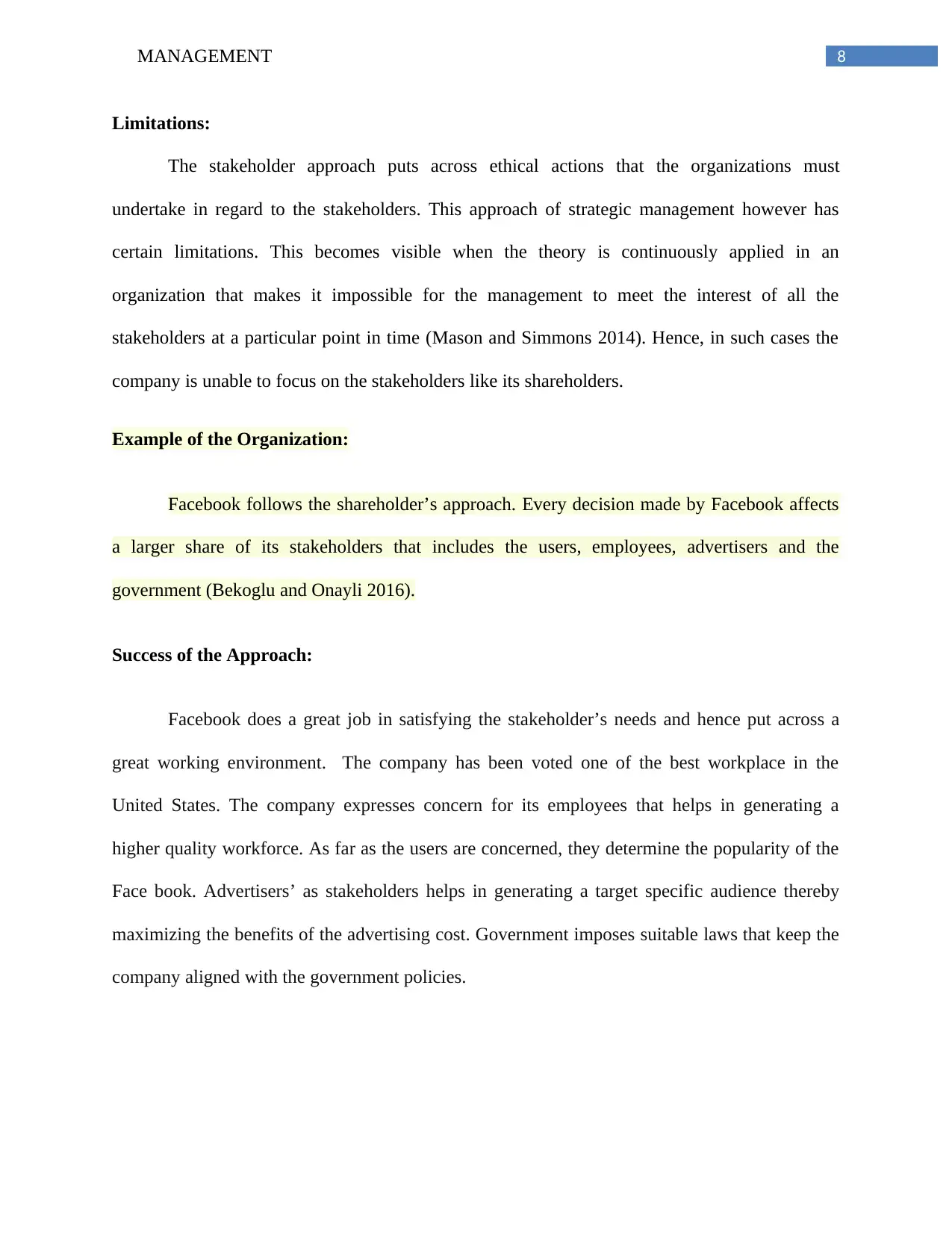
8MANAGEMENT
Limitations:
The stakeholder approach puts across ethical actions that the organizations must
undertake in regard to the stakeholders. This approach of strategic management however has
certain limitations. This becomes visible when the theory is continuously applied in an
organization that makes it impossible for the management to meet the interest of all the
stakeholders at a particular point in time (Mason and Simmons 2014). Hence, in such cases the
company is unable to focus on the stakeholders like its shareholders.
Example of the Organization:
Facebook follows the shareholder’s approach. Every decision made by Facebook affects
a larger share of its stakeholders that includes the users, employees, advertisers and the
government (Bekoglu and Onayli 2016).
Success of the Approach:
Facebook does a great job in satisfying the stakeholder’s needs and hence put across a
great working environment. The company has been voted one of the best workplace in the
United States. The company expresses concern for its employees that helps in generating a
higher quality workforce. As far as the users are concerned, they determine the popularity of the
Face book. Advertisers’ as stakeholders helps in generating a target specific audience thereby
maximizing the benefits of the advertising cost. Government imposes suitable laws that keep the
company aligned with the government policies.
Limitations:
The stakeholder approach puts across ethical actions that the organizations must
undertake in regard to the stakeholders. This approach of strategic management however has
certain limitations. This becomes visible when the theory is continuously applied in an
organization that makes it impossible for the management to meet the interest of all the
stakeholders at a particular point in time (Mason and Simmons 2014). Hence, in such cases the
company is unable to focus on the stakeholders like its shareholders.
Example of the Organization:
Facebook follows the shareholder’s approach. Every decision made by Facebook affects
a larger share of its stakeholders that includes the users, employees, advertisers and the
government (Bekoglu and Onayli 2016).
Success of the Approach:
Facebook does a great job in satisfying the stakeholder’s needs and hence put across a
great working environment. The company has been voted one of the best workplace in the
United States. The company expresses concern for its employees that helps in generating a
higher quality workforce. As far as the users are concerned, they determine the popularity of the
Face book. Advertisers’ as stakeholders helps in generating a target specific audience thereby
maximizing the benefits of the advertising cost. Government imposes suitable laws that keep the
company aligned with the government policies.
⊘ This is a preview!⊘
Do you want full access?
Subscribe today to unlock all pages.

Trusted by 1+ million students worldwide
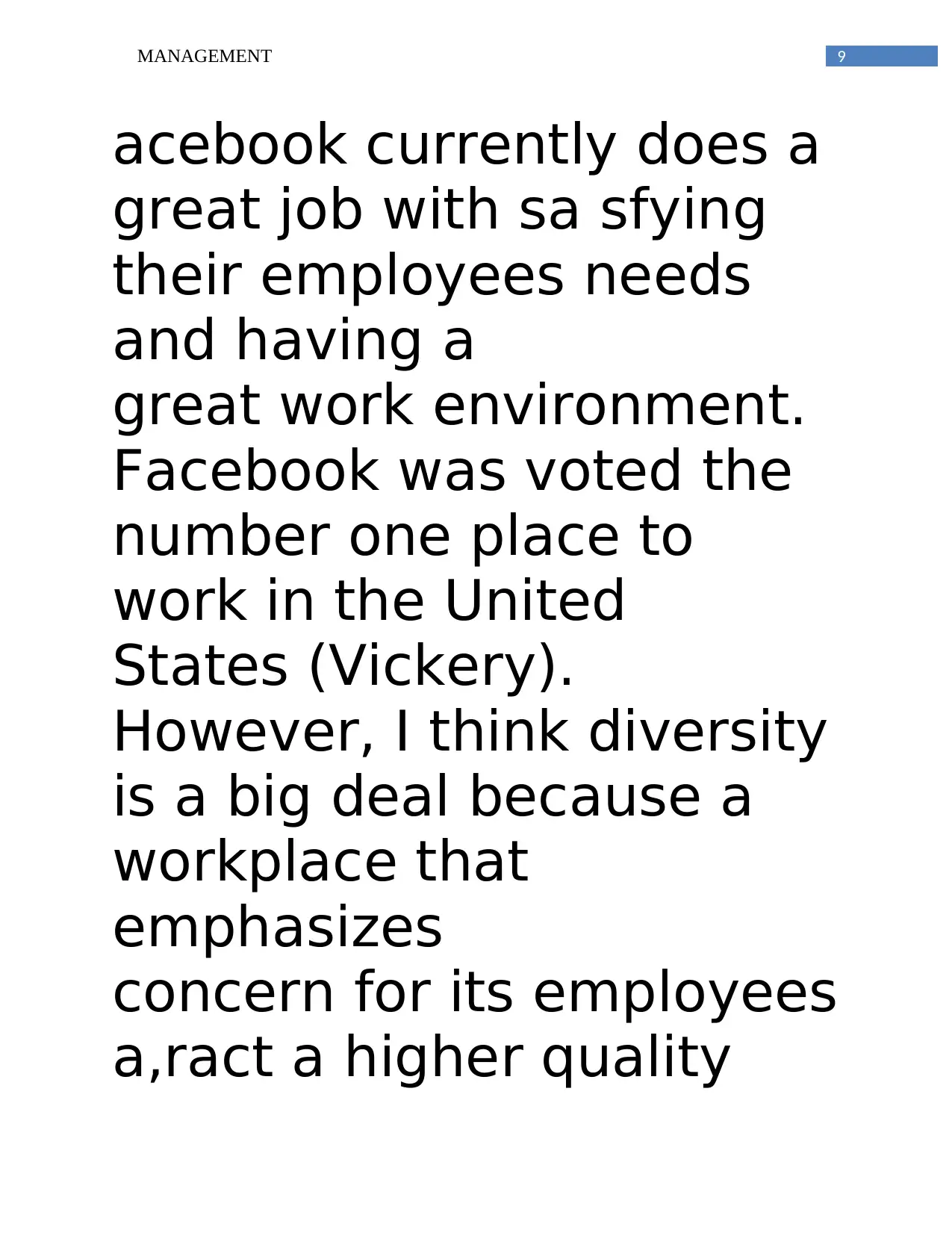
9MANAGEMENT
acebook currently does a
great job with sa sfying
their employees needs
and having a
great work environment.
Facebook was voted the
number one place to
work in the United
States (Vickery).
However, I think diversity
is a big deal because a
workplace that
emphasizes
concern for its employees
a,ract a higher quality
acebook currently does a
great job with sa sfying
their employees needs
and having a
great work environment.
Facebook was voted the
number one place to
work in the United
States (Vickery).
However, I think diversity
is a big deal because a
workplace that
emphasizes
concern for its employees
a,ract a higher quality
Paraphrase This Document
Need a fresh take? Get an instant paraphrase of this document with our AI Paraphraser
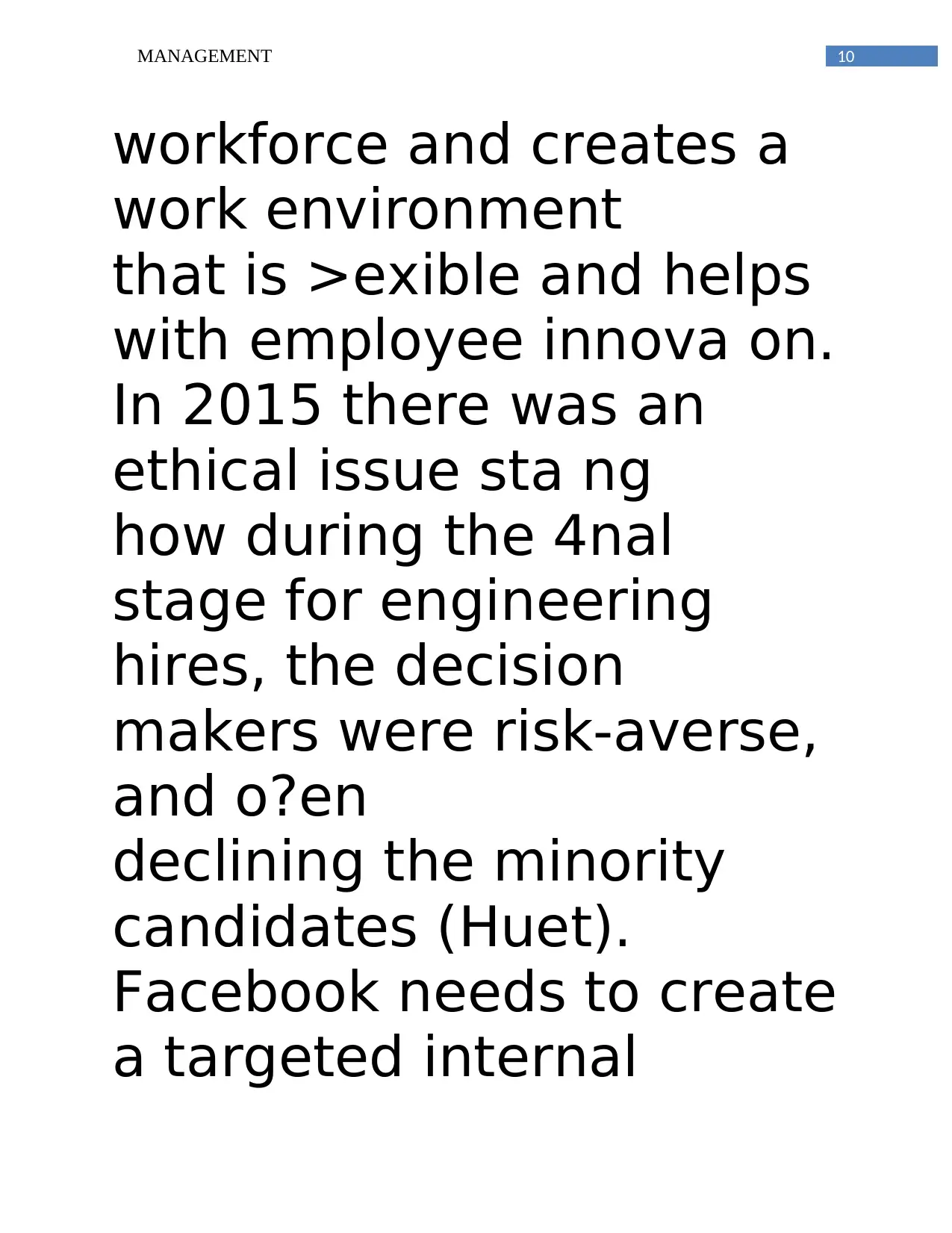
10MANAGEMENT
workforce and creates a
work environment
that is >exible and helps
with employee innova on.
In 2015 there was an
ethical issue sta ng
how during the 4nal
stage for engineering
hires, the decision
makers were risk-averse,
and o?en
declining the minority
candidates (Huet).
Facebook needs to create
a targeted internal
workforce and creates a
work environment
that is >exible and helps
with employee innova on.
In 2015 there was an
ethical issue sta ng
how during the 4nal
stage for engineering
hires, the decision
makers were risk-averse,
and o?en
declining the minority
candidates (Huet).
Facebook needs to create
a targeted internal
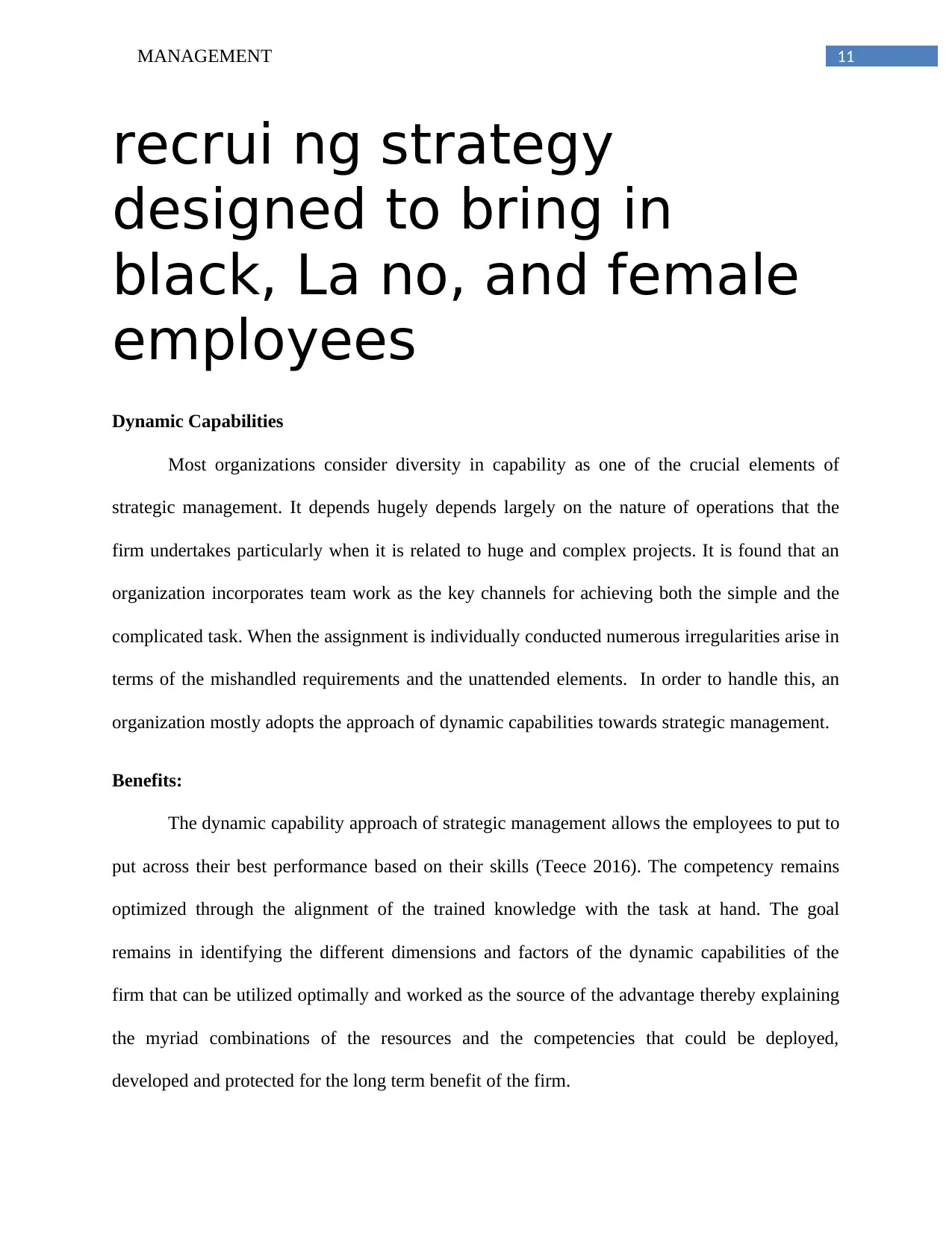
11MANAGEMENT
recrui ng strategy
designed to bring in
black, La no, and female
employees
Dynamic Capabilities
Most organizations consider diversity in capability as one of the crucial elements of
strategic management. It depends hugely depends largely on the nature of operations that the
firm undertakes particularly when it is related to huge and complex projects. It is found that an
organization incorporates team work as the key channels for achieving both the simple and the
complicated task. When the assignment is individually conducted numerous irregularities arise in
terms of the mishandled requirements and the unattended elements. In order to handle this, an
organization mostly adopts the approach of dynamic capabilities towards strategic management.
Benefits:
The dynamic capability approach of strategic management allows the employees to put to
put across their best performance based on their skills (Teece 2016). The competency remains
optimized through the alignment of the trained knowledge with the task at hand. The goal
remains in identifying the different dimensions and factors of the dynamic capabilities of the
firm that can be utilized optimally and worked as the source of the advantage thereby explaining
the myriad combinations of the resources and the competencies that could be deployed,
developed and protected for the long term benefit of the firm.
recrui ng strategy
designed to bring in
black, La no, and female
employees
Dynamic Capabilities
Most organizations consider diversity in capability as one of the crucial elements of
strategic management. It depends hugely depends largely on the nature of operations that the
firm undertakes particularly when it is related to huge and complex projects. It is found that an
organization incorporates team work as the key channels for achieving both the simple and the
complicated task. When the assignment is individually conducted numerous irregularities arise in
terms of the mishandled requirements and the unattended elements. In order to handle this, an
organization mostly adopts the approach of dynamic capabilities towards strategic management.
Benefits:
The dynamic capability approach of strategic management allows the employees to put to
put across their best performance based on their skills (Teece 2016). The competency remains
optimized through the alignment of the trained knowledge with the task at hand. The goal
remains in identifying the different dimensions and factors of the dynamic capabilities of the
firm that can be utilized optimally and worked as the source of the advantage thereby explaining
the myriad combinations of the resources and the competencies that could be deployed,
developed and protected for the long term benefit of the firm.
⊘ This is a preview!⊘
Do you want full access?
Subscribe today to unlock all pages.

Trusted by 1+ million students worldwide
1 out of 16
Related Documents
Your All-in-One AI-Powered Toolkit for Academic Success.
+13062052269
info@desklib.com
Available 24*7 on WhatsApp / Email
![[object Object]](/_next/static/media/star-bottom.7253800d.svg)
Unlock your academic potential
Copyright © 2020–2025 A2Z Services. All Rights Reserved. Developed and managed by ZUCOL.




